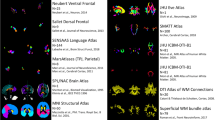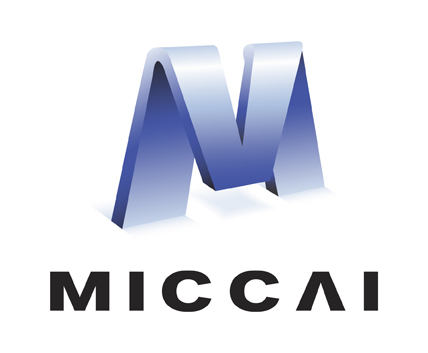Abstract
A central goal in systems neuroscience is to parcellate the brain into discrete units that are neurobiologically coherent. Here, we propose a strategy for consistent whole-brain parcellation of white matter (WM) and gray matter (GM) in individuals. We parcellate the brain into coherent parcels using non-negative matrix factorization based on voxel annotation using fiber clusters. Tractography is performed using an algorithm that mitigates gyral bias, allowing full gyral and sulcal coverage for reliable parcellation of the cortical ribbon. Experimental results indicate that parcellation using our approach is highly reproducible with 100% test-retest parcel identification rate and is highly consistent with significantly lower inter-subject variability than FreeSurfer parcellation. This implies that reproducible parcellation can be obtained for subject-specific investigation of brain structure and function.
This work was supported in part by United States National Institutes of Health (NIH) grants EB008374, MH125479, and EB006733.
Access this chapter
Tax calculation will be finalised at checkout
Purchases are for personal use only
Similar content being viewed by others
Change history
21 September 2021
“This work was supported in part by United States National Institutes of Health (NIH) grants EB008374, MH125479, and EB006733.”
References
Arslan, S., Rueckert, D.: Multi-level parcellation of the cerebral cortex using resting-state fMRI. In: Navab, N., Hornegger, J., Wells, W.M., Frangi, A.F. (eds.) MICCAI 2015. LNCS, vol. 9351, pp. 47–54. Springer, Cham (2015). https://doi.org/10.1007/978-3-319-24574-4_6
Bloy, L., Ingalhalikar, M., Eavani, H., Schultz, R.T., Roberts, T.P.L., Verma, R.: White matter atlas generation using HARDI based automated parcellation. NeuroImage 59(4), 4055–4063 (2012)
Destrieux, C., Fischl, B., Dale, A.M., Halgren, E.: A Sulcal depth-based anatomical parcellation of the cerebral cortex. NeuroImage 47, S151 (2009)
Schiffler, P., Tenberge, J.G., Wiendl, H., Meuth, S.G.: Cortex parcellation associated whole white matter parcellation in individual subjects. Front. Hum. Neurosci. 11, 352 (2017)
Fischl, B., et al.: Whole brain segmentation: automated labeling of neuroanatomical structures in the human brain. Neuron 33(3), 341–355 (2002)
Wakana, S., Jiang, H., Nagae-Poetscher, L.M., van Zijl, P.C.M., Mori, S.: Fiber tract-based atlas of human white matter anatomy. Radiology 230(1), 77–87 (2004)
Mori, S., et al.: Stereotaxic white matter atlas based on diffusion tensor imaging in an ICBM template. NeuroImage 40(2), 570–582 (2008)
Atkinson, A.P., Vuong, Q.C., Smithson, H.E.: Modulation of the face- and body-selective visual regions by the motion and emotion of point-light face and body stimuli. NeuroImage 59(2), 1700–1712 (2012)
Rohlfing, T.: Incorrect ICBM-DTI-81 atlas orientation and white matter labels. Front. Neurosci. 7, 4 (2013)
Xu, J., et al.: Tractography-based parcellation of the human middle temporal gyrus. Sci. Rep. 5, 18883 (2015)
Li, H., et al.: ATPP: a pipeline for automatic Tractography-Based brain parcellation. Front. Neuroinform. 11, 35 (2017)
López-López, N., Vázquez, A., Poupon, C., Mangin, J., Guevara, P.: Cortical surface parcellation based on intra-subject white matter fiber clustering. In: 2019 IEEE CHILEAN Conference on Electrical, Electronics Engineering, Information and Communication Technologies (CHILECON), pp. 1–6, November 2019
López-López, N., et al.: From coarse to Fine-Grained parcellation of the cortical surface using a Fiber-Bundle atlas. Front. Neuroinform. 14, 32 (2020)
Moreno-Dominguez, D., Anwander, A., Knösche, T.R.: A hierarchical method for whole-brain connectivity-based parcellation: whole-Brain Connectivity-Based parcellation. Hum. Brain Mapp. 35(10), 5000–5025 (2014)
Lefranc, S., et al.: Groupwise connectivity-based parcellation of the whole human cortical surface using watershed-driven dimension reduction. Med. Image Anal. 30, 11–29 (2016)
Desikan, R.S., et al.: An automated labeling system for subdividing the human cerebral cortex on MRI scans into gyral based regions of interest. NeuroImage 31(3), 968–980 (2006)
Destrieux, C., Fischl, B., Dale, A., Halgren, E.: Automatic parcellation of human cortical gyri and sulci using standard anatomical nomenclature. NeuroImage 53(1), 1–15 (2010)
Sotiropoulos, S.N., Zalesky, A.: Building connectomes using diffusion MRI: why, how and but. NMR Biomed. 32(4), e3752 (2019)
Van Essen, D.C., Smith, S.M., Barch, D.M., Behrens, T.E.J., Yacoub, E., Ugurbil, K.: WU-Minn HCP consortium: The WU-Minn human connectome project: an overview. NeuroImage 80, 62–79 (2013)
Sotiropoulos, S.N., Jbabdi, S., Andersson, J.L., Woolrich, M.W., Ugurbil, K., Behrens, T.E.J.: RubiX: combining spatial resolutions for Bayesian inference of crossing fibers in diffusion MRI. IEEE Trans. Med. Imaging 32(6), 969–982 (2013)
Glasser, M.F., et al.: The minimal preprocessing pipelines for the Human Connectome Project. NeuroImage 80, 105–124 (2013)
Wu, Y., Hong, Y., Feng, Y., Shen, D., Yap, P.T.: Mitigating gyral bias in cortical tractography via asymmetric fiber orientation distributions. Med. Image Anal. 59, 101543 (2020)
Chung, M.K., Adluru, N., Lee, J.E., Lazar, M., Lainhart, J.E., Alexander, A.L.: Cosine series representation of 3D curves and its application to white matter fiber bundles in diffusion tensor imaging. Stat. Interface 3(1), 69–80 (2010)
Park, H.S., Jun, C.H.: A simple and fast algorithm for k-medoids clustering. Expert Syst. Appl. 36(2, Part 2), 3336–3341 (2009)
Wu, Y., Hong, Y., Ahmad, S., Lin, W., Shen, D., Yap, P.-T.: Tract dictionary learning for fast and robust recognition of fiber bundles. In: Martel, A.L., et al. (eds.) MICCAI 2020. LNCS, vol. 12267, pp. 251–259. Springer, Cham (2020). https://doi.org/10.1007/978-3-030-59728-3_25
Kriegel, H.P., Kroger, P., Schubert, E., Zimek, A.: Interpreting and unifying outlier scores. In: Proceedings of the 2011 SIAM International Conference on Data Mining. Proceedings, pp. 13–24. Society for Industrial and Applied Mathematics, April 2011
O’Donnell, L.J., et al.: Automated white matter fiber tract identification in patients with brain tumors. NeuroImage. Clinical 13, 138–153 (2017)
Zhang, F., Wu, Y., Norton, I., Rigolo, L., Rathi, Y., Makris, N., O’Donnell, L.J.: An anatomically curated fiber clustering white matter atlas for consistent white matter tract parcellation across the lifespan. NeuroImage 179, 429–447 (2018)
Fürböck, C.: Non-negative matrix factorization as a tool for fMRI analysis of dynamicity and individuality of functional networks (2020)
Varikuti, D.P., et al.: Evaluation of non-negative matrix factorization of grey matter in age prediction. NeuroImage 173, 394–410 (2018)
Thompson, E., et al.: Non-negative data-driven mapping of structural connections with application to the neonatal brain. NeuroImage 222, 117273 (2020)
Eickhoff, S.B., Yeo, B.T.T., Genon, S.: Imaging-based parcellations of the human brain. Nature reviews. Neuroscience 19(11), 672–686 (2018)
Hoyer, P.O.: Non-negative matrix factorization with sparseness constraints. J. Mach. Learn. Res. JMLR 5, 1457–1469 (2004)
Mairal, J., Bach, F., Ponce, J., Sapiro, G.: Online learning for matrix factorization and sparse coding. J. Mach. Learn. Res. JMLR 11(1) (2010)
Boutsidis, C., Gallopoulos, E.: SVD based initialization: a head start for nonnegative matrix factorization. Pattern Recogn. 41(4), 1350–1362 (2008)
Arslan, S., Ktena, S.I., Makropoulos, A., Robinson, E.C., Rueckert, D., Parisot, S.: Human brain mapping: a systematic comparison of parcellation methods for the human cerebral cortex. NeuroImage 170, 5–30 (2018)
Bastiani, M., Shah, N.J., Goebel, R., Roebroeck, A.: Human cortical connectome reconstruction from diffusion weighted MRI: the effect of tractography algorithm. NeuroImage 62(3), 1732–1749 (2012)
Glasser, M.F., Van Essen, D.C.: Mapping human cortical areas in vivo based on myelin content as revealed by T1- and T2-weighted MRI. J. Neurosci. Official J. Soc. Neurosci. 31(32), 11597–11616 (2011)
Wassermann, D., et al.: The white matter query language: a novel approach for describing human white matter anatomy. Brain Struct. Funct. 221(9), 4705–4721 (2016). https://doi.org/10.1007/s00429-015-1179-4
Author information
Authors and Affiliations
Corresponding author
Editor information
Editors and Affiliations
Rights and permissions
Copyright information
© 2021 Springer Nature Switzerland AG
About this paper
Cite this paper
Wu, Y., Ahmad, S., Yap, PT. (2021). Highly Reproducible Whole Brain Parcellation in Individuals via Voxel Annotation with Fiber Clusters. In: de Bruijne, M., et al. Medical Image Computing and Computer Assisted Intervention – MICCAI 2021. MICCAI 2021. Lecture Notes in Computer Science(), vol 12907. Springer, Cham. https://doi.org/10.1007/978-3-030-87234-2_45
Download citation
DOI: https://doi.org/10.1007/978-3-030-87234-2_45
Published:
Publisher Name: Springer, Cham
Print ISBN: 978-3-030-87233-5
Online ISBN: 978-3-030-87234-2
eBook Packages: Computer ScienceComputer Science (R0)





